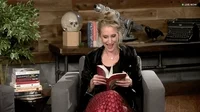
I didn't really understand how this
class was going to benefit me as a future math teacher prior to starting this
course. Growing up, I wasn’t very fond of reading many books unless I stumbled
upon something that interested me. I found myself reading only when it was necessary
for classes. I’ve always had a hard time with reading comprehension because I
would have to read something repeatedly in order to grasp what I read. This
class has shown me that implementing literacy into the classroom is beneficial
for students. I’ve also come to the realization that I’ve never had an issue
with reading and interpreting math equations and word problems. Reading in math
is much different than reading in other subjects, but a lot of the same
strategies used to interpret the various math problems can be used in the other
content areas as well.
Two of the
most influential things that I enjoyed in this course was book clubs and
podcasts. At first, I wasn’t thrilled to read or even find a book to present,
but it was exciting to watch my peers do their pitches and it made it hard to choose
just one book to read. The City of Ember was
such a good book and I am going to purchase the whole series because I was so
intrigued. I enjoyed discussing the book with my book club and it was good to
see they were just as captivated into it as I was. The podcast was also a good
experience. My group and I enjoyed creating the podcast starting with the intro
and outro music and discussing the science and social studies content that was demonstrated
throughout the book. I didn’t really know what a podcast was before this
assignment and never listened to any before. Since this assignment, I’ve
subscribed to a few different podcast channels and I listen to them frequently.
I’ve learned a lot of different strategy
lessons from Subject Matters that I
would love to implement in my classroom. I will definitely use think-a-louds to
help my students visually see how I would approach a problem and thinking
strategies that can come into play to make tackling math problems a lot easier.
I can recall some of my math teachers
demonstrating think-a-louds on the projector and I can honestly say it was very
helpful. I can also remember doing entrance and exit slips in school. I now
understand the purpose of them and will also use those in my classroom. I also
enjoyed both of the strategy lessons that I presented in the class. The
vocabulary predictions lesson was fun and engaging. I could see myself giving
students key words to categorize them and to see if they determine what they believe
the chosen article is about. The dramatic role play was fun to watch the groups
act out as a weather team. Everyone worked as a team and everyone seemed to
enjoy it. I haven’t quite figured out exactly how I would utilize the dramatic
role play strategy yet, but if I do, I will use this in my class. Overall, this
class has changed my perspective of bringing literacy in my math class and providing
my students with the necessary tools to be successful in reading.
Autumn
547








